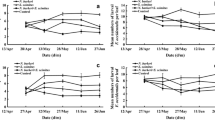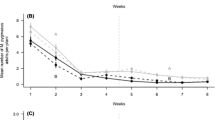Abstract
Biological control against phytophagous arthropods has been widely used under greenhouse conditions. Its success is dependent on a number of factors related to the abiotic conditions and to the interactions between pests and biological control agents. In particular, when multiple predator species are introduced to suppress one pest, competitive interactions might occur, including intraguild predation (IGP). In tomato crops, the spider mite Tetranychus urticae Koch is a very problematic phytophagous mite and its control is not yet satisfactory. In 2012 and 2013, the ability of a potential new predatory mite Phytoseiulus macropilis (Banks) was assessed, alone and in the presence of Macrolophus pygmaeus Rambur. Macrolophus pygmaeus is a polyphagous mirid supposed to predate on P. macropilis. Both years, under greenhouse conditions, the effectiveness of the two predators was compared between the following treatments: T. urticae, T. urticae + P. macropilis, T. urticae + M. pygmaeus, and T. urticae + P. macropilis + M. pygmaeus. The number of arthropods per tomato plant over time indicated that P. macropilis well-controlled the population of T. urticae, whereas M. pygmaeus had a very limited impact. Furthermore, there was no evidence of IGP between the two predators but in the presence of M. pygmaeus, P. macropilis tended to have a more clumped spatial distribution. Further studies should clarify the number and location of inoculation points to optimize the control of T. urticae by P. macropilis.




Similar content being viewed by others
References
Ali F (1998) Life tables of Phytoseiulus macropilis (Banks) (Gamasida: Phytoseiidae) at different temperatures. Exp Appl Acarol 22:335–342
Cakmak I, Janssen A, Sabelis MW, Baspinar H (2009) Biological control of an acarine pest by single and multiple natural enemies. Biol Control 50:60–65
Choh Y, van der Hammen T, Sabelis MW, Janssen A (2010) Cues of intraguild predators affect the distribution of intraguild prey. Oecologia 163:335–340
Coombs MR, Bale JS (2014) Thermal biology of the spider mite predator Phytoseiulus macropilis. Biocontrol 59:205–217. doi:10.1007/s10526-014-9559-x
Enkegaard A, Brødsgaard HF, Hansen D (2001) Macrolophus caliginosus: functional response to whiteflies and preference and switching capacity between whiteflies and spider mites. Entomol Exp Appl 101:81–88
Ferla NJ, Marchetti M, Johann L, Haetinger C (2011) Functional response of Phytoseiulus macropilis under different Tetranychus urticae (Acari: Phytoseiidae, Tetranychidae) population density in laboratory. Zool Curitiba Impresso 28:17–22. doi:10.1590/S1984-46702011000100003
Ferrero M, Calvo FJ, Atuahiva T et al (2011) Biological control of Tetranychus evansi Baker & Pritchard and Tetranychus urticae Koch by Phytoseiulus longipes Evans in tomato greenhouses in Spain [Acari: Tetranychidae, Phytoseiidae]. Biol Control 58:30–35. doi:10.1016/j.biocontrol.2011.03.012
Gerson U, Weintraub PG (2012) Mites (Acari) as a factor in greenhouse management. Annu Rev Entomol 57:229–247
Gerson U, Smiley RL, Ochoa R (2003) Mites (Acari) for pest control. Blackwell, London
Greco NM, Liljesthröm GG, Sànchez NE (1999) Spatial distribution and coincidence of Neoseiulus californicus and Tetranychus urticae (Acari: Phytoseiidae, Tetranychidae) on strawberry. Exp Appl Acarol 23:567–580
Hamdi F, Chadoeuf J, Chermiti B, Bonato O (2013) Evidence of cannibalism in Macrolophus pygmaeus, a natural enemy of whiteflies. J Insect Behav 26:614–621. doi:10.1007/s10905-013-9379-3
Hansen DL, Brodsgaard HF, Enkegaard A (1999) Life table characteristics of Macrolophus caliginosus preying upon Tetranychus urticae. Entomol Exp Appl 93:269–275
Højsgaard S, Halekoh U, Yan J (2006) The R package geepack for generalized estimating equations. J Stat Software 15:1–11
Holt RD, Polis GA (1997) A theoretical framework for intraguild predation. Am Nat 149:745–764
Janssen A, Sabelis MW, Magalhães S, Montserrat M, van der Hammen T (2007) Habitat structure affects intraguild predation. Ecology 88:2713–2719
Lucas E, Rosenheim JA (2011) Influence of extraguild prey density on intraguild predation by heteropteran predators: a review of the evidence and a case study. Biol Control 59:61–67. doi:10.1016/j.biocontrol.2011.05.010
Magalhães S, Janssen A, Hanna R, Sabelis MW (2002) Flexible antipredator behaviour in herbivorous mites through vertical migration in a plant. Oecologia 132:143–149. doi:10.1007/s00442-002-0950-4
Malausa JC, Trottin-Caudal Y (1996) Advances on the strategy of use of the predaceous bug, Macrolophus caliginosus (Heteroptera, Miridae) in glasshouse crops. Zoophytophagous Heteroptera Implic. Life Hist. Integr. Pest Manag. Thomas Say Publications (Etats-Unis), pp 178–189
Malézieux S, Girardet C, Navez B, Cheyrias J (1995) Contre l’aleurode des serres en cultures de tomates sous abris: utilisation et développement de Macrolophus caliginosus associé à Encarsia formosa. Phytoma 471:29–32
McMurtry JA, Croft BA (1997) Life-styles of Phytoseiid mites and their roles in biological control. Annu Rev Entomol 42:291–321
Messelink GJ, Janssen A (2014) Increased control of thrips and aphids in greenhouses with two species of generalist predatory bugs involved in intraguild predation. Biol Control 79:1–7
Nachman G, Zemek R (2002) Interactions in a tritrophic acarine predator–prey metapopulation system IV: effects of host plant condition on Tetranychus urticae (Acari: Tetranychidae). Exp Appl Acarol 26:43–70. doi:10.1023/A:1020929318422
Oliveira H, Janssen A, Pallini A et al (2007) A phytoseiid predator from the tropics as potential biological control agent for the spider mite Tetranychus urticae Koch (Acari: Tetranychidae). Biol Control 42:105–109
Oliveira H, Fadini MAM, Venzon M et al (2009) Evaluation of the predatory mite Phytoseiulus macropilis (Acari: Phytoseiidae) as a biological control agent of the two-spotted spider mite on strawberry plants under greenhouse conditions. Exp Appl Acarol 47:275–283. doi:10.1007/s10493-008-9217-z
Pallini A, Janssen A, Sabelis MW (1999) Spider mites avoid plants with predators. Exp Appl Acarol 23:803–815
Perdikis DC, Lykouressis DP (2002) Life table and biological characteristics of Macrolophus pygmaeus when feeding on Myzus persicae and Trialeurodes vaporariorum. Entomol Exp Appl 102:261–272
Pilkington LJ, Messelink G, van Lenteren JC, Le Mottee K (2010) ‘Protected biological control’—biological pest management in the greenhouse industry. Biol Control 52:216–220. doi:10.1016/j.biocontrol.2009.05.022
Polis GA, Myers CA, Holt RD (1989) The ecology and evolution of intraguild predation: potential competitors that eat each other. Annu Rev Ecol Syst 20:297–330. doi:10.1146/annurev.es.20.110189.001501
R Core Team (2015) A language and environment for statistical computing. R Foundation for statistical computing Vienna. http://www.R-project.org/
Rosenheim JA, Kaya HK, Ehler LE et al (1995) Intraguild predation among biological control agents: theory and evidence. Biol Control 5:303–335. doi:10.1006/bcon.1995.1038
Shipp L, Johansen N, Vänninen I, Jacobsen R (2011) Greenhouse climate: an important consideration when developing pest management programs for greenhouse crops. Acta Hort ISHS 893:133–143
Skirvin DJ, Fenlon JS (2003) The effect of temperature on the functional response of Phytoseiulus persimilis (Acari: Phytoseiidae). Exp Appl Acarol 31:37–49
Taylor LR (1961) Aggregation, variance and the mean. Nature 189:732–735
Trottin-Caudal Y, Millot P (1994) Lutte intégrée contre les ravageurs sur tomate sous abri, situation et perspectives en France. IOBC WPRS Bull 17:25–28
van Lenteren JC (2000) A greenhouse without pesticides: fact or fantasy? Crop Prot 19:375–384
van Lenteren JC (2012) The state of commercial augmentative biological control: plenty of natural enemies, but a frustrating lack of uptake. Biocontrol 57:1–20. doi:10.1007/s10526-011-9395-1
Vance-Chalcraft HD, Rosenheim JA, Vonesh JR et al (2007) The influence of intraguild predation on prey suppression and prey release: a meta-analysis. Ecology 88:2689–2696
Vangansbeke D, Schrijver L, Spranghers T et al (2013) Alternating temperatures affect life table parameters of Phytoseiulus persimilis, Neoseiulus californicus (Acari: Phytoseiidae) and their prey Tetranychus urticae (Acari: Tetranychidae). Exp Appl Acarol 61:285–298. doi:10.1007/s10493-013-9704-8
Walzer A, Schausberger P (2013) Phenotypic plasticity in anti-intraguild predator strategies: mite larvae adjust their behaviours according to vulnerability and predation risk. Exp Appl Acarol 60:95–115. doi:10.1007/s10493-012-9624-z
Walzer A, Moder K, Schausberger P (2009) Spatiotemporal within-plant distribution of the spider mite Tetranychus urticae and associated specialist and generalist predators. Bull Entomol Res 99:457. doi:10.1017/S0007485308006494
Yan J (2002) ‘Geepack’: yet another package for generalized estimating equations. R News 2(3):12–14
Zar JH (2010) Biostatistical analysis, 5th edn. Pearson International Edition, New Jersey
Zhang Z-Q, Sanderson JP (1997) Patterns, mechanisms and spatial scale of aggregation in generalist and specialist predatory mites (Acari: Phytoseiidae). Exp Appl Acarol 21:393–404
Acknowledgments
We would like to thank Jean Klieber and Pierre Massot for data collection, Serge Fischer for providing the initial colony of P. macropilis, Thomas Steinger for his help with data analysis, and Maxime Ferrero, Dominique Fleury, and Serge Fischer for constructive suggestions during the project. The University of Applied Sciences and Arts of Western Switzerland (HES-SO) provided funding through the program RealTech SAGEX 30225. This work is part of Vincent Gigon’s Ph.D. thesis.
Author information
Authors and Affiliations
Corresponding author
Rights and permissions
About this article
Cite this article
Gigon, V., Camps, C. & Le Corff, J. Biological control of Tetranychus urticae by Phytoseiulus macropilis and Macrolophus pygmaeus in tomato greenhouses. Exp Appl Acarol 68, 55–70 (2016). https://doi.org/10.1007/s10493-015-9976-2
Received:
Accepted:
Published:
Issue Date:
DOI: https://doi.org/10.1007/s10493-015-9976-2




